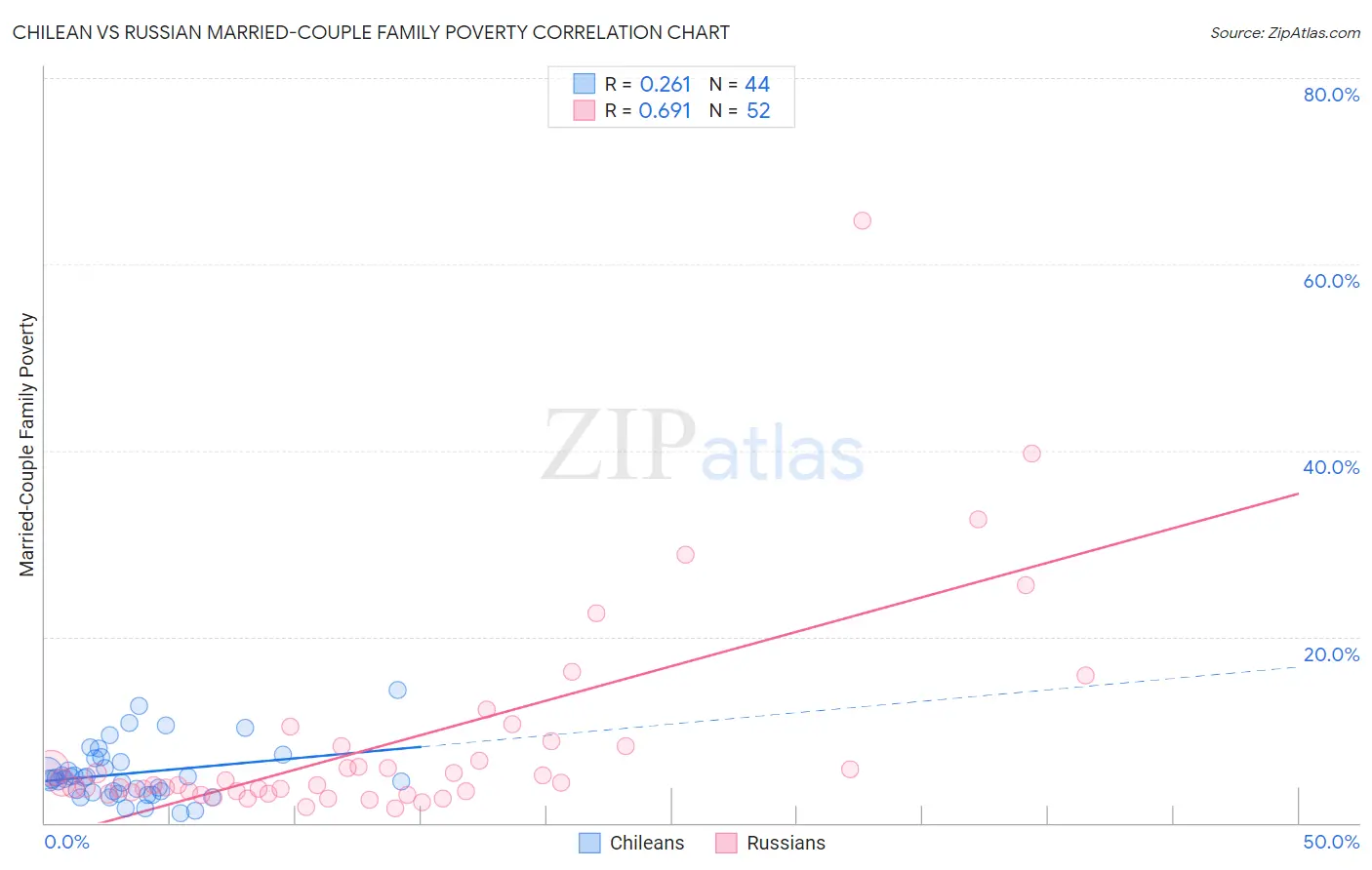Chilean vs Russian Married-Couple Family Poverty
COMPARE
Chilean
Russian
Married-Couple Family Poverty
Married-Couple Family Poverty Comparison
Chileans
Russians
4.9%
MARRIED-COUPLE FAMILY POVERTY
86.0/ 100
METRIC RATING
138th/ 347
METRIC RANK
4.3%
MARRIED-COUPLE FAMILY POVERTY
99.7/ 100
METRIC RATING
52nd/ 347
METRIC RANK
Chilean vs Russian Married-Couple Family Poverty Correlation Chart
The statistical analysis conducted on geographies consisting of 255,436,750 people shows a weak positive correlation between the proportion of Chileans and poverty level among married-couple families in the United States with a correlation coefficient (R) of 0.261 and weighted average of 4.9%. Similarly, the statistical analysis conducted on geographies consisting of 502,513,768 people shows a significant positive correlation between the proportion of Russians and poverty level among married-couple families in the United States with a correlation coefficient (R) of 0.691 and weighted average of 4.3%, a difference of 14.4%.

Married-Couple Family Poverty Correlation Summary
| Measurement | Chilean | Russian |
| Minimum | 1.1% | 1.6% |
| Maximum | 14.3% | 64.7% |
| Range | 13.2% | 63.1% |
| Mean | 5.3% | 8.7% |
| Median | 4.8% | 4.1% |
| Interquartile 25% (IQ1) | 3.4% | 3.3% |
| Interquartile 75% (IQ3) | 6.7% | 8.3% |
| Interquartile Range (IQR) | 3.4% | 5.0% |
| Standard Deviation (Sample) | 3.0% | 11.4% |
| Standard Deviation (Population) | 2.9% | 11.3% |
Similar Demographics by Married-Couple Family Poverty
Demographics Similar to Chileans by Married-Couple Family Poverty
In terms of married-couple family poverty, the demographic groups most similar to Chileans are Guamanian/Chamorro (4.9%, a difference of 0.13%), German Russian (5.0%, a difference of 0.23%), Immigrants from Portugal (5.0%, a difference of 0.29%), Immigrants from Brazil (5.0%, a difference of 0.34%), and Immigrants from China (5.0%, a difference of 0.34%).
| Demographics | Rating | Rank | Married-Couple Family Poverty |
| Immigrants | Eastern Europe | 90.5 /100 | #131 | Exceptional 4.9% |
| Puget Sound Salish | 90.4 /100 | #132 | Exceptional 4.9% |
| Immigrants | Kenya | 90.2 /100 | #133 | Exceptional 4.9% |
| Samoans | 90.2 /100 | #134 | Exceptional 4.9% |
| Assyrians/Chaldeans/Syriacs | 89.4 /100 | #135 | Excellent 4.9% |
| Immigrants | Hungary | 88.7 /100 | #136 | Excellent 4.9% |
| Guamanians/Chamorros | 86.5 /100 | #137 | Excellent 4.9% |
| Chileans | 86.0 /100 | #138 | Excellent 4.9% |
| German Russians | 85.1 /100 | #139 | Excellent 5.0% |
| Immigrants | Portugal | 84.8 /100 | #140 | Excellent 5.0% |
| Immigrants | Brazil | 84.6 /100 | #141 | Excellent 5.0% |
| Immigrants | China | 84.6 /100 | #142 | Excellent 5.0% |
| Immigrants | Egypt | 83.4 /100 | #143 | Excellent 5.0% |
| Hmong | 83.2 /100 | #144 | Excellent 5.0% |
| Immigrants | Spain | 79.9 /100 | #145 | Good 5.0% |
Demographics Similar to Russians by Married-Couple Family Poverty
In terms of married-couple family poverty, the demographic groups most similar to Russians are Immigrants from Lithuania (4.3%, a difference of 0.030%), Burmese (4.3%, a difference of 0.040%), Turkish (4.3%, a difference of 0.13%), Welsh (4.3%, a difference of 0.15%), and Australian (4.3%, a difference of 0.21%).
| Demographics | Rating | Rank | Married-Couple Family Poverty |
| Serbians | 99.8 /100 | #45 | Exceptional 4.3% |
| British | 99.8 /100 | #46 | Exceptional 4.3% |
| Immigrants | South Central Asia | 99.8 /100 | #47 | Exceptional 4.3% |
| Australians | 99.7 /100 | #48 | Exceptional 4.3% |
| Turks | 99.7 /100 | #49 | Exceptional 4.3% |
| Burmese | 99.7 /100 | #50 | Exceptional 4.3% |
| Immigrants | Lithuania | 99.7 /100 | #51 | Exceptional 4.3% |
| Russians | 99.7 /100 | #52 | Exceptional 4.3% |
| Welsh | 99.7 /100 | #53 | Exceptional 4.3% |
| Austrians | 99.7 /100 | #54 | Exceptional 4.3% |
| French | 99.7 /100 | #55 | Exceptional 4.3% |
| Immigrants | Zimbabwe | 99.7 /100 | #56 | Exceptional 4.3% |
| Immigrants | Netherlands | 99.7 /100 | #57 | Exceptional 4.3% |
| Czechoslovakians | 99.7 /100 | #58 | Exceptional 4.4% |
| Immigrants | Sweden | 99.6 /100 | #59 | Exceptional 4.4% |